
This post continues where the previous post left off. Recap: This post talks about some of the plants I saw on the second half of a recent Wainwright Coast to Coast walking tour sponsored by National Geographic. The walk started on July 24th and ended on August 3rd and included 14 of us and 2 guides walking about 140 miles in 12 days. The flowers mentioned here were all spotted trail side between July 31 (day 1) and Aug 3(day 7), what I’m calling the second part of the walk (the eastern part). The day designation will be used in the picture captions below.
July 31 (day 8) :: Reeth to Richmond
Aug 1 (day 9) :: Richmond to Osmotherly
Aug 2 (day 10) :: Osmotherly to Blakey Ridge
Aug 3 (day 11) :: Blakey Ridge to Grosmont
Aug 4 (day 12) :: Grosmont to Robin Hood’s Bay
In this part of the walk, I was also aided by the book Collins Complete British Wild Flowers which I picked up in Richmond.
Day 8: Ribes uva-crispa – GooseberryAs we leave Reeth we pass by the Marrick Priory and someone points out this gooseberry plant.
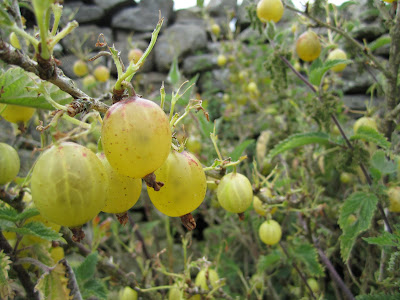

Day 8: Geum rivale - Water Avens
As we walk up a steep part in Steps Wood I notice this plant. The dried flower heads are waiting to catch on to a bit of fur to be transported to some other location.

Day 8: Alchemilla vulgaris - Lady's Mantle
A house garden in Marrick.

Day 8: Dipsacus fullonum - Wild TeaselLeaving the quaint Marrick and heading toward Nun Cote Nook and the Nun Cote Nook Tea Room (we call it Elaine’s after one of the owners). A welcome stop for snacks.


Day 8: Origanum vulgare - Wild Marjoram
Near Whitcliffe Wood as we make our way to Richmond following the River Swale.

Day 8: Lonicera periclymenum – Honeysuckle
We walk into Richmond and pass some houses with pretty gardens which include this honeysuckle.

Day 9: Veronica persica - Common Field-speedwell
Found this plant along the fields that Wainwright had deemed flat and tedious (in his dry way) that are along the Vale of Mowbray. This flower grows along the edge of a barley field. As we walk we heard carnival music in the distance.

Day 9: Inachis io - Peacock ButterflyOn our way to Catterick Bridge and above the River Swale we see this Peacock Butterfly. This one stands still long enough to photograph it.

Day 9: Impatiens glandulifera - Indian BalsamWe had not seen this plant at all until now and suddenly we encounter large areas of it along the River Swale as we approach Catterick Bridge.

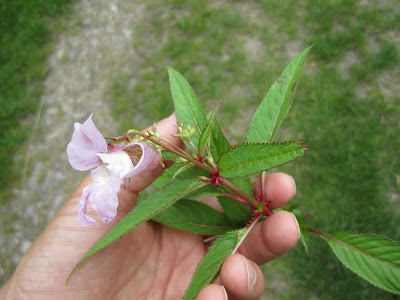

Day 10: Macrolepiota rhacodes - Shaggy Parasol Mushroom
Walking out of Osmotherley toward Beacon Hill someone points out this mushroom.
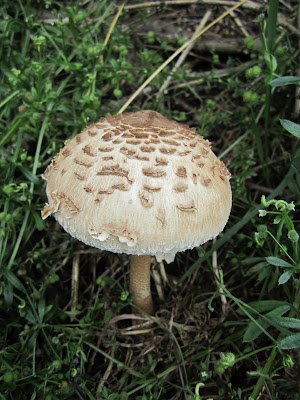
Day 10: Arctium minus - Lesser Burdock
The day before, at the Mount Grace Priory, I try a Fentimans Dandelion (leaf) and Burdock (root) soda that is delicious. And so I start seeing burdock everywhere I look. So did the inventor of velcro (p. 14). This plant is spotted near Scugdale.


Day 10: Vaccinium uliginosum - Bog Bilberry
Scarth Wood Moor. Not too many bilberries to be found at this time of the year. I think at this point we are on the Cleveland Way Trail.


Day 10: Vaccinium uliginosum - Bog BilberryBilberry heaven on Scarth Wood Moor looking toward Whorl Hill.

Day 10: Bog Bilberry (left) and Heather (right) on Round Hill

Day 10: Calluna vulgaris - Heather (also called Ling)What mention of plants of this area would be complete without mentioning heather? We see heather from day 1 (St. Bees) in small bits here and there, but it isn’t until the Yorkshire Moors that we see large tracts of it in its preferred conditions of acidic soil. The term heather is commonly used to refer to plants in the Ericaceae family for both the Calluna and Erica genus. (Bilberry is also in the same family.)

Day 10: Two types of heather. Calluna (left), Erica (right)

Day 10: Erica tetralix – Cross-leaved Heath
What’s not shown are the leaves that identify this as tetralix.

Day 11: Pavonia pavonia - Emperor Moth caterpillar
The most common food for the Pavonia pavonia is heather. Pavonia is Latin for peacock referring to the moth’s spotted wings looking like peacock feathers. This one was spotted (!) crossing a road near Danby Head.
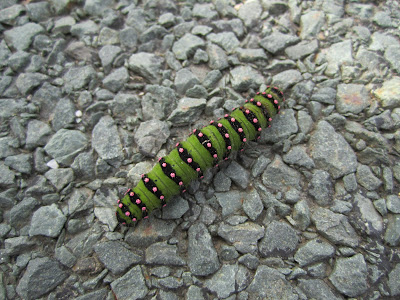
Day 11: Cirsium palustre - Marsh Thistle (white)
Dona, one my tour mates (always observant) spots this and at first I think it is a bleached out, spent flower. I am wrong. The Marsh Thistle can occasionally be white. We see white thistle as we leave Blakey Ridge (the Lion Inn) and head to Glaisdale. These photos are taken near Danby Head.

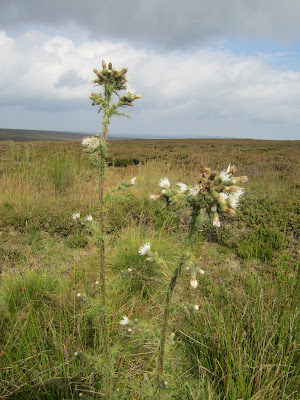
Day 11: Cirsium palustre - Marsh Thistle (white and purple)

Day 11: Eriophorum angustifolium - Common CottongrassThese photos were taken on Flat Howe. We climb out of Grosmont, passing some quarries, and then through Flat Howe. Areas of cottongrass can indicate peat bogs to be avoided by walkers.
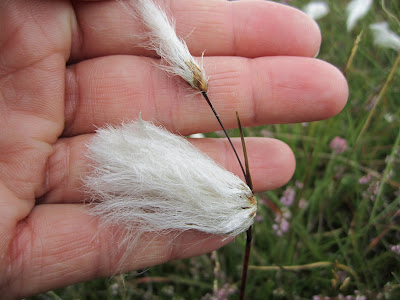

Day 11: Bibio pomonae - Heather Fly (male)
We had seen these flies, usually in higher ground – heath, for several days. Sometimes the air is thick with them. We did not know what they were. Finally, a request to the folks at www.WhatsThatBug.com resolved the issue.

Day 11: Euphrasia officinalis – EyebrightA tiny plant that I see on the edge of Glaisdale Moor.

Day 11: Lysimachia vulgaris - Yellow Loosestrife
This lysimachia is photographed in a garden in Glaisdale, up the hill from the train station.
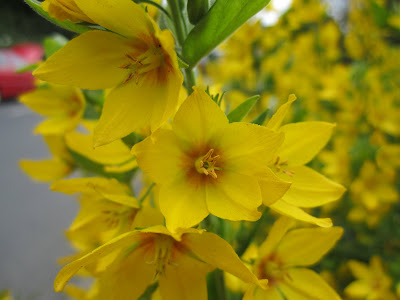
Day 11: Epilobium angustifolium – Fireweed
Who needs another photo of fireweed? This photograph is taken outside of Egton Bridge heading toward Grosmont.

Day 11: Centaurea nigra - Common Knapweed
It’s easy to want to overlook knapweed especially when you see so many thistle species all day. It takes me a while to realize these were different. We are leaving Egton Bridge on a dirt road along the River Esk on a beautiful afternoon and the flowers along the road are incredible.

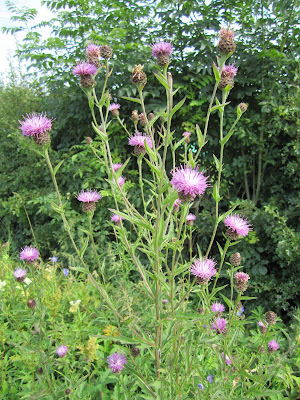
Day 12: Vicia cracca - Tufted Vetch
We see a lot of vetch over the 12 days. It’s not a plant that overwhelms other vegetation as the Common Cleavers (Galium aparine) does.

Day 12: Silene dioica - Red Campion
A plant that I don’t see that much on the trip, maybe I missed it. This photograph is taken near Hawsker Bottoms, on a shady spot on the side of the road, as we make our way to the North Sea.

Collins Complete British Wild Flowers
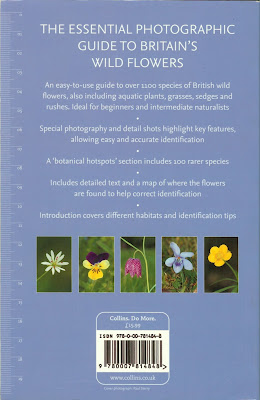

No comments:
Post a Comment
All comments go through a moderation process. Even though it may not look like the comment was accepted, it probably was. Check back in a day if you asked a question. Thanks!